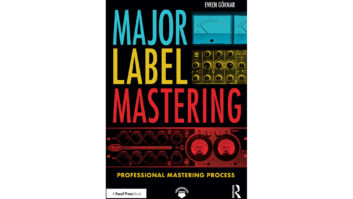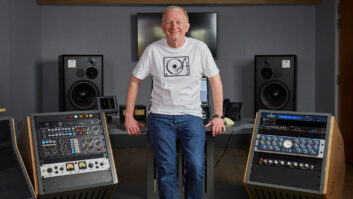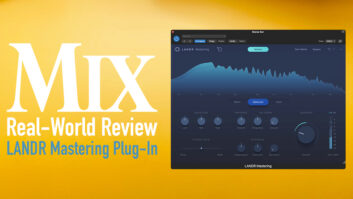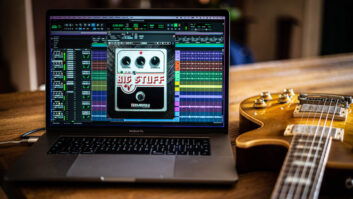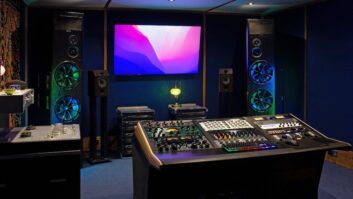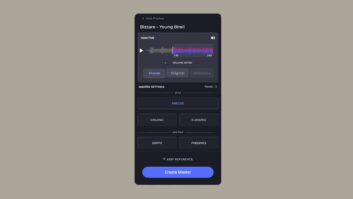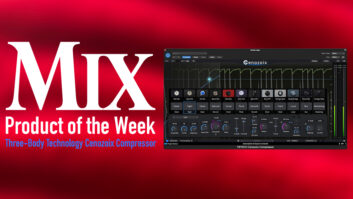For as long as most of us can remember, America’s music business has been concentrated in just three cities: Los Angeles, New York and Nashville. Other regions have had their moments in the sun-Detroit was Motown, San Francisco had its Sound, and Seattle had grunge-but the Big Three remain the power centers, the places you have to go to “make it” not only as a performer but as an engineer.
Mastering engineers in particular have been bound by this rule, in part because success often depends on close relationships with the major labels, but also because mastering projects are measured in hours or days rather than weeks or months. That means a mastering house needs a much broader client base to survive than does a recording studio. And because they can’t thrive in a vacuum, mastering studios are to the recording business as canaries are to coal mines, indicating whether local conditions are sufficient to sustain life. Viewed from that perspective, the presence of mastering activity beyond the boundaries of the Big Three tells us something not only about mastering, but also about the recording industry as a whole.
It turns out that it is possible to survive and thrive not just in second-tier cities such as San Francisco or Boston, but in places like Portland or Phoenix, Boulder or Orlando. And you don’t necessarily have to be a Bob Ludwig-with decades of New York experience under your belt-before hanging up your shingle outside of the Big Three. To find out how it’s done, and how the business in such communities differs from the major recording centers, we spoke with owner/engineers from six mastering houses. Their experience is in mastering, but most of their observations apply to anyone outside the major markets who is building a career in recording.
THE PANELISTS, IN THEIR OWN WORDSGeorge Blood, principal, Delaware Valley Digital Media (Philadelphia): I’ve been doing this for 15 years. I grew up in Philadelphia, went to the University of Chicago, was hired by WFMT to work on the Philadelphia Orchestra’s nationally syndicated radio series and began freelancing on the side. The biggest skill I had was the ability to razor blade-edit music. This grew into what is now DVDMedia.
Jay Frigoletto, owner and principal engineer, Atlanta Digital (Atlanta): I’ve been working in the Atlanta market for about five years. I graduated from Berklee School of Music in Boston and apprenticed at a mastering studio with an engineer who worked on projects like David Bowie and Aerosmith. I then took a job as a staff engineer at a post facility in Atlanta, bought a Sonic Solutions system and started doing freelance editing and other work for local and major-label clients, including Arrested Development and D.A.R.P. Noticing Atlanta’s lack of experienced mastering engineers and professional facilities, I got bank financing and started Atlanta Digital just over two-and-a-half years ago.
David Glasser, chief engineer and owner, Airshow Mastering (Boulder, Colo.): We have two locations: the original studio in Springfield, Virginia-now run by co-owner Charlie Pilzer-and a new multiroom facility in Boulder, which is where I am. When we built the Virginia studio, affordable premastering was a novelty, and we quickly found a niche with local artists and some good independent labels. When we built the Boulder facility, we had eight years of mastering experience under our belt, as well as a Grammy for Best Historical Album, the Anthology of American Folk Music. We also had mastered 40 Grammy-nominated CDs and had a national clientele of mostly independent labels and artists.
Bob Katz, president, Digital Domain (Orlando, Fla.): We moved Digital Domain to Orlando from New York City in June of 1996. I had founded Digital Domain in 1990. For several years before that, I had recorded and mastered audiophile jazz and pop CDs for Chesky Records, and transferred and restored their historic classical reissues at either New York Digital or BMG mastering studios. Prior to that, since 1972, I freelanced as a recording engineer and frequently participated in mastering sessions, observing other “masters” at work.
Rick McMillen, owner, SuperDigital Ltd. (Portland, Ore.): We started about six years ago with the first “real” mastering facility in our region. I was a live tour mixer for eight years, including six years with Kenny G. Then I worked as a studio engineer for years. Wanting to EQ, edit and archive my own live tapes and studio masters was the impetus to start buying fancy gear, and I liked mastering because a session is over in a day or less and it can be a lot of fun, almost like live mixing!
David Shirk, president, Sonorous Mastering (Tempe, Ariz.): We’ve been open at our current location since July of 1997. My mastering experience started in 1989 at American Helix in Lancaster, Pa., which grew from a “small fry” CD plant to the third largest supplier of CDs on the planet. We had a huge range of clients, from Sony- and EMI-level stuff down to street-level local bands. I stayed with that company through its acquisition by KAO Infosystems in 1993, and then in 1995 I relocated to Phoenix, where I worked for a small mastering facility before starting my own place.
What was it about your area that motivated you to open your mastering business there, and how has your actual experience in the area compared with your expectations?
Blood: Many secondary markets, while small compared to the Big Three, aren’t served particularly well. Within months of arriving to work with the Philadelphia Orchestra, I was getting calls to do other things. Three years later I moved the studio out of my house. I’ve been very surprised by the size of the market. We’ve seen double-digit growth every year for 15 years.
Frigoletto: Atlanta had a dozen SSL rooms and a rapidly growing hip hop and R&B scene, with companies like D.A.R.P., LaFace and So So Def. There was also a strong alternative rock scene with Capricorn Records and the influence of Georgia bands like R.E.M. and Collective Soul. With all that, the only place to get something mastered was with an assistant in a walk-in closet at a studio or in somebody’s bedroom. Most of the work went to Nashville or New York. That’s still the greatest challenge-getting the larger clients to stop going out of town and understand that there is a viable alternative locally.
Glasser: We needed to enlarge our facility to better accommodate our growing clientele, and we chose Boulder for a break from the crowded East Coast. Boulder’s pace suited us. We hoped that our clients would view it as a great “destination” city, where they could come to master a record, hike in the mountains, fish, ski or take in some hot springs. Increasingly, that is happening, with producers flying in from California, Texas, New Orleans and elsewhere. The town has a great local music scene, and many national acts pass through here.
Katz: Initially, I was pretty neutral about the Orlando area as far as the music biz goes. We moved here for the weather and the easier-paced living, and it’s midway between Nashville and Miami. We lost about 30 percent of our business initially, including a few New York clients who didn’t want to travel this far, but we kept most of them. Some travel down, but most send tapes.
Since moving here, we’ve gained a wonderful Seattle-based “country-rock-acoustic-folk” record company and have mastered about 15 CDs for the United States Marine Band! Then, word of mouth brought us considerable Orlando-based business: three serious Florida-based record companies, plus work for an independent Platinum engineer and even some work for Disney and a couple of Miami-based engineers. So, after two-and-a-half years in Orlando, we have almost tripled our business over New York. I see a big future for this town; it’s snowballing very rapidly on top of a monstrous Disney seed.
McMillen: We serve one of the smaller markets-the Pacific Northwest-but we felt we could grow the market and take some chances. When we started, there was nothing remotely resembling mastering in our area-you’d have to fly to L.A. and spend way too much money with one of those old vinyl-cutting/U-Matic guys. Also, to some degree our mastering grew out of our everyday needs in our duplication services division, where we make Digalog cassettes and CDs. We started mastering with one Mac IIci with a 660 drive. Now we have about $100,000 sunk into gizmos alone, and we just moved into our new location, where we are building two new rooms.
Shirk: Over the years I had built a client base that wasn’t necessarily dependent on geography. Many of my clients are from out of state and just FedEx me their projects. I knew that opening a business meant committing to a location, and I really like living in the Southwest-great golf! This is a thriving area on many levels, and there’s a nice local music scene that I feel is growing and maturing along with the rest of the valley. Being located ten minutes from the Arizona State University campus, with 50,000 students, is also a bonus for our growth.
Characterize the most common types of clients in your regional market in terms of musical genres and their label situation (major, indie, self-distributed, etc.) and their budgets.
Blood: We see a very wide range of clients, from people just trying to break into the business to the Philadelphia Orchestra and the Opera Company of Philadelphia. Like the clientele, the label situation varies very widely. With the recent difficulties in the classical music market, many mid-market projects that would have gone to mid-level labels just two years ago are opting to go it on their own. Our card rate is half what’s charged in New York City, and we have a few steady clients-including Pogus and New World Records-who find that FedEx is no more expensive than a crosstown courier, so we can compete. In pop, most of our clients are small indie labels, demos or self-release.
Frigoletto: Atlanta is best known for its hip hop and R&B scene, and it’s no surprise that more than half of the work that comes in is in that style. There are also a lot of great rock bands in town, and a cool funk/jazz scene, too. In addition to the major label sessions, which often tend to be the smaller or newer artists, there is some indie work and a lot of self-distributed projects. A substantial amount of work also comes from demos, EPs and compilations for the many production companies in town. Most of the work is from Georgia, but a respectable amount comes from locations like Japan, Canada, New York and most of the Southern states. Budgets run from a couple hundred dollars for a short, quick demo to a couple thousand for the better label jobs but tend to be between $600 and $1,200 most of the time.
Glasser: Airshow gained a following with many acoustic artists-folk, bluegrass, “new acoustic,” alternative country-and there is a good deal of that in Colorado and the mountain West, as well as new age and Native American artists and labels. Then there is the indie rock scene and a fair number of jazz artists. Many are self-distributed regional acts, some are on independent labels, and a handful are on major labels. We also do a lot of restoration work for labels like Revenant, Folkways and Rounder. At the Virginia studio, we are close to the Federal government and institutions like the Smithsonian, so we work with the various military bands, Folkways Records and the Library of Congress.
Katz: We have a few major-label clients and would love to have more. I refuse to be typecast-I do well with many kinds of music. My “metal” clients might be shocked to learn that I also edit and master classical music from score. Ninety percent of our clients are from outside of Florida. Over 60 percent of our clients are indies with as few as three to perhaps 200 records in their catalogs. Thirty percent are “self-distributed,” but a number of popular musicians now fall into that category, and some of them are into their second or third album with us.
McMillen: Usually any of the major-label acts that live in our area will have their projects done at one of the “name” houses because that’s where their record company sends them. About 90 percent of our clients are indie or unsigned bands, so we really run the gamut of musical styles, from classical chorales to garage bands to bebop. Self-distributed is pretty much the operative word for most of our clients, and they seem pretty proud of that.
Shirk: I work on local projects that are anything from the Phoenix Symphony to death metal. Most clients in this market are indie or self-distributed, but there are the well-known Tempe bands [Gin Blossoms, Refreshments] that have had a glimpse of major-label success. Budgetwise, the local clients usually fall into two categories: those who are funded by a label and understand the importance of mastering, and those who are learning the process of recording and generally have limited budgets. My ratio of local to national work I’d say is about 60 percent local and 40 percent coming from labels and studios outside this region.
How is your facility designed and equipped, and how (if at all) has that been affected by your location?
Blood: The rooms were designed by Doug Jones of EASI in Chicago, following the LEDE design principles. Our monitors are B&W 801s and 805s, and KEF 103.2s, all driven by Bryston amps. We have four networked Sonic Solutions DAWs-two SSPs and two USPs. Three have full NoNoise, and one has DVD Creator. We have the Pacific Microsonics Model One ADC/DAC, Lexicon reverb, Studer A80, all the usual toys.
Frigoletto: The room is spacious and was specifically designed and built as a mastering room. It was also tuned by Bob Hodas. It’s professionally done, but not a “million-dollar, built from the ground up” kind of facility. Equipment is top of the line: fully expanded 96kHz Sonic System, Manley, Apogee, Quested, Focusrite Blue, Dolby Digital 5.1-everything you need to make great records. The market isn’t ready to pay for a million-dollar construction for a mastering room just yet-nor is my bank!-but I hope it will get there.
Glasser: Our Boulder facility is brand-new and was purpose-designed from the ground up. We wanted to distinguish our facility as a superbly equipped studio in a great locale, even though we’ve had to educate certain clients and convince them it’s worth spending a bit more for mastering services than they’re used to paying at a “project mastering studio.” The two mastering rooms are large and ready for surround-monitoring, and we’ve got a solid infrastructure with a custom balanced power system, central machine room, production room, full kitchen and sunny lounge. Equipment is the usual high-end mastering stuff: Sonic Solutions with MediaNet and NoNoise, Weiss 102, Sony 1630, Studer, Sontec, Manley and Apogee gear, as well as Pacific Microsonics HDCD.
Katz: Our location has had no effect on the design of the facility or, fortunately, our ability to pay for top equipment. Our room has a cathedral ceiling, and the position of the loudspeakers-mounted on 150-pound, sand-filled stands anchored to the concrete-produces minimal diffraction, so extremely fine details can be heard in the sound. We have a Studer C37 analog tape transport modified to 30 ips 11/42-inch, with custom-wound heads feeding Ampex MR-70 tube electronics. Our A/D converter was built by me using Ultra Analog modules, while the D/A converter is a Counterpoint DA-10 designed by Peter Madnick and modified by me. Our Sonic Solutions system is equipped with all options, including high-sample-rate audio. Two Digital Domain VSP Model P sample rate converter, jitter reduction and routing units are part of the digital chain, as is a Meridian Model 518 redithering processor, Audio Alchemy redithering and dejittering processor, products from Waves and many other processors.
McMillen: We are building two rooms in a new facility inside a building built by Paramount Pictures in 1930. One room will be tuned for 5.1 surround. We love digital, but we also wouldn’t go without GML analog gear, or Apogee or Manley. We have a pretty well-equipped room that should go for bigger bucks, but our area lacks the big album budgets, so we have to be more competitive in the way we function. What would cost about $250 an hour in L.A. can be had in Portland for less than $100.
Shirk: The room started out as a pretty good near-field listening environment, which is why we took this particular building. We’ve got analog electronics by Manley and Avalon, Apogee Platinum Series converters and UV1000, an MCI JH110 11/42-inch machine, TC 5000, full-blown Sonic Solutions and a pile of other toys. The location hasn’t really affected my decisions on gear. I just wanted to invest in equipment that I knew was top-shelf, that would enable me to attain a finished product that could compete with the big guys.
What do you see as the keys to doing well outside of the Big Three markets?
Blood: I gave up trying to compete against the Big Three years ago. If you do good work, treat your clients well and price your services fairly-to you and your clients-I’m convinced the work will be there.
Frigoletto: We need to keep more big Atlanta artists in Atlanta. Beyond that, it’s important to understand that in a secondary market, not every gig is going to be a major-label gig. There’s plenty of other work to go around, and you need to make sound business decisions and not just try to finance your dream studio. Unless you are independently wealthy, you need to make the numbers work. Networking is the other important part. Meet all the people you can, and eventually those contacts will lead to better jobs.
Glasser: We maintain close working relationships with both local and out-of town clients, including engineers, producers and studios, making our facility a creative resource they can use not only for mastering, but as a place to evaluate mixes, get CD dubs, attend product evaluations and shoot-outs, etc.
Katz: Quality of service, attention to detail, knowledge, equipment and results. Come to think of it, that’s no different than being in the Big Three, is it?
McMillen: First, adapt or die! Technical innovation will make mastering an increasingly diversified service. Second, you need to convince the public that “mastering” doesn’t just mean “some guy with a computer in a closet!” Third, it’s about reputation. In a smaller market you see a lot of the same faces again and again. Anyone can buy the gear, but it’s the engineers that make the difference. We like our clients, we care about their work and treat them like kings.
Shirk: Always trying to stay current technically, and provide the best service possible to our customers. I try to put myself in the place of every client I work with and understand the emotions they’re experiencing in the process of recording a disc project. Everyone has a set of certain needs, but in most cases the simple stuff is what matters. Most of my accounts are friends as much as they are clients, and that’s the kind of connection I want to create, the ones that last.
Any other observations on your situation and the pros and cons of working outside the major music markets?
Blood: Spend more time working on keeping the clients you get than getting new ones. If you don’t return that phone call from the cranky client who owes you money, then you can expect him to go elsewhere. Maybe he was referring a friend in L.A.
Frigoletto: Working outside the major markets means you can live a little cheaper and maybe work for yourself, which can be a blessing and curse at the same time. It also means that big credits are harder to come by, whether or not you do the work as well or even better than many of the guys in the Big Three markets. You also have to educate your consumers a bit more in a market that may be less knowledgeable about your craft. It can still be a rewarding, if lower-profile, career.
Glasser: I think it’s a myth that most music is made in the major markets. There are independent labels literally all over the place. That is where a lot of the exciting, compelling music is being made.
Katz: The biggest con is that in New York, our clients could arrive by convenient taxi or subway, and we lose a certain genre of client that works in a major Manhattan label and doesn’t want to travel out. Conversely, mastering has grown into a more decentralized situation, and I thank Bob Ludwig for making it legitimate to leave New York. I figure if producers are willing to fly to Portland, Maine, in December, they’ll fly here, too!
McMillen: Educating a young market to what real mastering is all about can be challenging. But we do get to watch the trends in major markets and see the guys with big bucks making the mistakes, so we can learn from them. Also, thanks to new communications technologies I’m really only a couple of milliseconds away, and my clients have the potential to compete with the world.
Shirk: There is not as much direct competition here, though also not as much backyard business being generated. There is the ability to be part of the expansion process as growth occurs in your own region, and lower operating costs compared with the Big Three. And there is less personal strain due to issues associated with overpopulation. But it’s tough to find a good cannoli!
